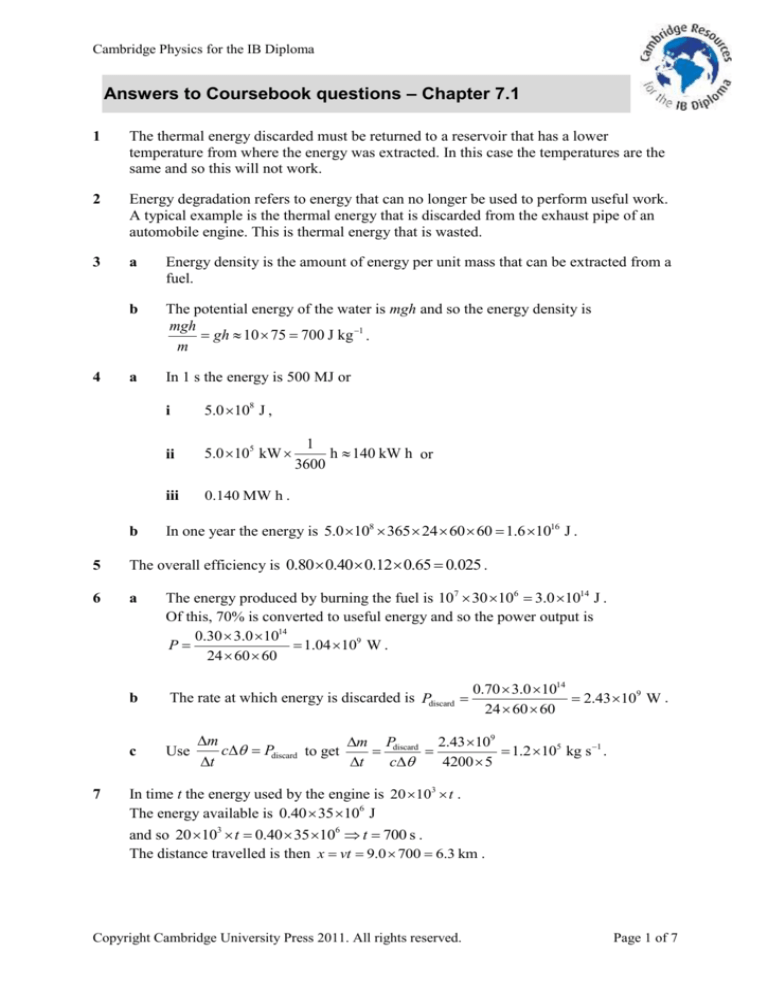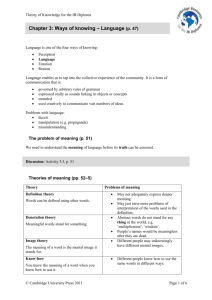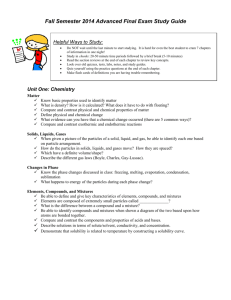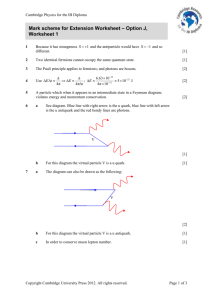
Cambridge Physics for the IB Diploma
Answers to Coursebook questions – Chapter 7.1
1
The thermal energy discarded must be returned to a reservoir that has a lower
temperature from where the energy was extracted. In this case the temperatures are the
same and so this will not work.
2
Energy degradation refers to energy that can no longer be used to perform useful work.
A typical example is the thermal energy that is discarded from the exhaust pipe of an
automobile engine. This is thermal energy that is wasted.
3
a
Energy density is the amount of energy per unit mass that can be extracted from a
fuel.
b
The potential energy of the water is mgh and so the energy density is
mgh
gh 10 75 700 J kg 1 .
m
a
In 1 s the energy is 500 MJ or
4
b
i
5.0 108 J ,
ii
5.0 105 kW
iii
0.140 MW h .
1
h 140 kW h or
3600
In one year the energy is 5.0 108 365 24 60 60 1.6 1016 J .
5
The overall efficiency is 0.80 0.40 0.12 0.65 0.025 .
6
a
The energy produced by burning the fuel is 107 30 106 3.0 1014 J .
Of this, 70% is converted to useful energy and so the power output is
0.30 3.0 1014
P
1.04 109 W .
24 60 60
b
The rate at which energy is discarded is Pdiscard
c
Use
7
0.70 3.0 1014
2.43 109 W .
24 60 60
m
m Pdiscard 2.43 109
c Pdiscard to get
1.2 105 kg s 1 .
t
t
c
4200 5
In time t the energy used by the engine is 20 103 t .
The energy available is 0.40 35 106 J
and so 20 103 t 0.40 35 106 t 700 s .
The distance travelled is then x vt 9.0 700 6.3 km .
Copyright Cambridge University Press 2011. All rights reserved.
Page 1 of 7
Cambridge Physics for the IB Diploma
8
The useful energy produced each day is
E Pt 1.0 109 24 60 60 8.64 1013 J .
The energy produced by burning the coal is therefore
8.64 1013
0.40
Ec 2.16 1014 J .
Ec
So the mass of coal to be burned is m
9
10
2.16 1014
7.2 106 kg per day.
30 106
a
The fissionable isotope of uranium is U-235. This is found in very small
concentrations in uranium ore, which is mostly U-238. Enrichment means
increasing the concentration of U-235 in a sample of uranium.
b
The moderator is the part of the nuclear reactor where neutrons released from the
fission reactions slow down as a result of collisions with the atoms of the
moderator. The temperature of the moderator can be kept constant with a cooling
system that removes the excess thermal energy generated in the moderator.
c
Critical mass refers to the least mass of uranium that must be present for nuclear
fission reactions to be sustained. If the mass of uranium is too small (i.e. below
the critical mass) the neutrons may escape without causing fission reactions.
a
The reaction is
235
92
94
1
U+ 01 n 140
54 Xe 38 Sr 2 0 n . The mass difference is
δ (235.043992 92 0.000549) 1.008665
(139.921636 54 0.000549) (93.915360 38 0.000549) 2 1.008665)
0.198331 u
And so the energy released is E 0.198331 931.5c2
b
MeV c2 185 MeV .
With N reactions per second the power output is N 185 MeV s 1 .
In other words, N 185 106 1.6 1019 200 106 N 6.8 1018 s1 .
11
a
One kilogram of uranium corresponds to
1000
4.26 moles and so
235
4.26 6.02 1023 2.57 1024 nuclei.
Each nucleus produces 200 MeV and so the energy produced by 1 kg (the energy
density) is 2.57 1024 200 106 1.6 1019 8 1013 J kg 1 .
b
8 1013
2.7 106 kg .
6
30 10
Copyright Cambridge University Press 2011. All rights reserved.
Page 2 of 7
Cambridge Physics for the IB Diploma
12
13
500 106
1.25 109 J .
0.40
Hence the number of fission reactions per second is
1.25 109
3.9 1019 .
200 106 1.6 1019
a
The energy that must be produced in 1 s is E
b
The number of nuclei required to fission per second is 3.9 1019 ,
3.9 1019
which corresponds to
6.5 105 mol ,
6.02 1023
i.e. a mass of 6.5 105 235 103 1.5 105 kg s 1 .
a
For a diagram see page 421 in Physics for the IB Diploma.
b
i
Fuel rods are pipes in which the fuel (i.e. uranium-235) is kept.
ii
Control rods are rods that can absorb neutrons. These are lowered in or
raised out of the moderator so that the rate of reactions is controlled. The
rods are lowered in if the rate is too high – the rods absorb neutrons so that
these neutrons do not cause additional reactions. They are raised out if the
rate is too small leaving the neutrons to cause further reactions.
iii
The moderator is the part of the nuclear reactor where neutrons released
from the fission reactions slow down as a result of collisions with the atoms
of the moderator. The temperature of the moderator can be kept constant
with a cooling system that removes the excess thermal energy generated in
the moderator.
It is kinetic energy of the neutrons produced which is converted into thermal
energy in the moderator as the neutrons collide with the moderator atoms.
14
Up to you.
15
A solar panel receives solar radiation incident on it and uses it to heat up water, i.e. it
converts solar energy into thermal energy.
The photovoltaic cell converts the solar incident on it to electrical energy.
16
In order for the electrons to make the transition to the conduction band, an energy equal
to the difference between the valence and the conduction band must be supplied.
If the photons’ energy is only 2 eV and the gap energy greater than 2 eV, this will not
be possible.
17
The power that must be supplied is 3.0 kW, and this equals 700 A 0.70 0.50 . Hence
700 A 0.70 0.50 3.0 103 A 12 m2 .
18
The power that is provided is 0.65 240 A
mc 300 4200 35
and this must equal
.
t
12 60 60
300 4200 35
A 6.5 m 2 .
Hence 0.65 700 A
12 60 60
Copyright Cambridge University Press 2011. All rights reserved.
Page 3 of 7
Cambridge Physics for the IB Diploma
19
For solar radiation of 600 W m−2 the power incident on the panel is
600 4.0 0.60 1440 W .
The energy needed to warm the water is mc 150 4200 30 1.89 107 J
and so 1440 t 1.89 107 t
20
1.89 107
1.31104 s 3.6 h .
1440
a
From the graph this is about T 338 K
b
P IA 400 2 800 W .
c
The useful power is the 320 W that is extracted.
320
0.40 .
The efficiency is thus
800
21
The power supplied at the given speed is (reading from the graph) 100 kW.
Hence the energy supplied in 100 h is 100 103 1000 60 60 3.6 1011 J .
22
We look at the power formula for windmills, P
23
1
Av3 to deduce that:
2
a
the area will increase by a factor of 4 if the length is doubled and so the power
increases by a factor of 4,
b
the power will increase by a factor of 23 8 and
c
the combined effect is 4 8 32 .
d
Not all the kinetic energy of the wind can be extracted because not all the wind is
stopped by the windmill (as the formula has assumed). In addition, there will be
frictional losses as the turbines turn as well as losses due to turbulence.
a
The proof of this formula is on page 427 in Physics for the IB Diploma.
b
Assumptions include:
i
no losses of energy due to frictional forces as the turbines turn,
ii
no turbulence in the air and
iii
all the air stops at the turbines so that the speed of the air behind the
turbines is zero (which is impossible).
Copyright Cambridge University Press 2011. All rights reserved.
Page 4 of 7
Cambridge Physics for the IB Diploma
24
The power in the wind before hitting the turbine is
and right after passing through the turbine is
1
1 Av13
2
1
2 Av23
2
so the extracted power is
1
1
1
1 Av13 2 Av23 π 1.52 (1.2 8.03 1.8 3.03 ) 2.0 kW .
2
2
2
25
1
1
Av3 we get 25 103 1.2 A 9.03 A 57.16 m 2
2
2
2
and so πR 57.16 R 4.3 m .
The assumptions made are the usual ones (see Q23):
From P
i
no losses of energy due to frictional forces as the turbines turn
ii
no turbulence in the air and
iii
all the air stops at the turbines so that the speed of the air behind the turbines is
zero (which is impossible).
26
The potential energy of a mass m of water is m gh and so the power developed is
the rate of change of this energy,
m
gh 500 9.8 40 1.96 105 2.0 105 W .
i.e.
t
27
The potential energy of a mass m of water is m gh and so the power developed is
m
V
gh
gh Qgh .
the rate of change of this energy, i.e.
t
t
28
The amount of electrical energy generated will always be less than the energy required
to raise the water back to its original height. This is because the electrical energy
generated is less than what theoretically could be provided by the water (because of
various losses). So this claim cannot be correct.
Copyright Cambridge University Press 2011. All rights reserved.
Page 5 of 7
Cambridge Physics for the IB Diploma
29
a
L
A
LA in the trough is raised so it now occupies a crest.
2
The centre of mass has been raised by A and so the potential energy is
1
LAgA gA2 L .
2
2
A mass of volume
The frequency of the wave is f and so the potential energy per second per unit
P 1
1
wavefront length L is gA2 f gA2 v .
L 2
2
P 1
P 1
gA2 v we find 103 9.8 5.02 4.8 5.9 105 W m 1.
L 2
L 2
b
From
c
5.9 105 L 1.0 106 L 1.7 m .
30
The OWC works by sending air that is compressed as a wave approaches the shore
through a turbine that turns in a magnetic field producing electricity. As the wave
recedes, air flows through the turbine in reverse, again turning it. The big advantage of
the OWC device is that, by adjusting the valves through which the air flows, the air
speed can be increased to values suitable for producing AC electricity at frequencies
much higher than the (low) water wave frequency.
31
a
Coal power plant: chemical energy of coal thermal energy kinetic energy
of steam kinetic energy of turbine electrical energy.
b
Hydroelectric power plant: potential energy of water kinetic energy of water
kinetic energy of turbine electrical energy.
c
Wind turbine: kinetic energy of wind kinetic energy of turbine electrical
energy.
d
Nuclear power plant: nuclear energy of fuel kinetic energy of neutrons
thermal energy in moderator kinetic energy of steam kinetic energy of
turbine electrical energy.
Copyright Cambridge University Press 2011. All rights reserved.
Page 6 of 7
Cambridge Physics for the IB Diploma
32
a
The surface area of the tank is 2 1.0 1.0 4 1.0 0.10 2.4 m2
and so its volume is 2.4 5.0 103 1.2 102 m3
and hence its mass is 1.2 102 1200 14.4 kg .
b
The tank receives energy at a rate of 800 W.
T T
Q
kA 1 2
Thus from
t
x
T 20
T1 31 C .
we get 0.80 800 0.30 1.0 1
5.0 103
c
C 14.4 450 100 4200 4.3 105 J K 1 .
d
The thermal energy supplied to the water equals the energy it receives from the
sun minus what it loses to the surroundings.
The rate at which energy is received from the sun is AIin and it loses energy at a
T 20
rate kA
.
x
The thermal energy needed to raise the water-tank system temperature is
Q
T
C
.
Q C T and so the rate at which the energy is used is
t
t
T
T 20
AI in kA
Hence, C
.
t
x
e
The average is
f
At this rate the final temperature is reached after a time given by
11
7.2 104 t 1.5 104 s 4.2 h .
t
31 20
25.5 C .
2
T
25.5 20
5
1.0 800 0.80 0.30 1.0
Hence 4.3 10
t
5.0 103
T
7.2 104 K s 1 .
giving
t
Copyright Cambridge University Press 2011. All rights reserved.
Page 7 of 7







